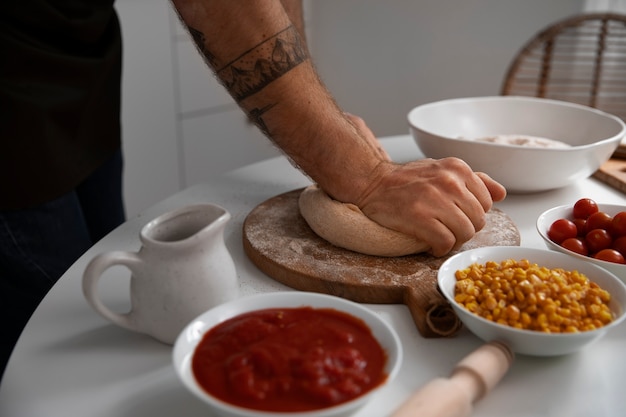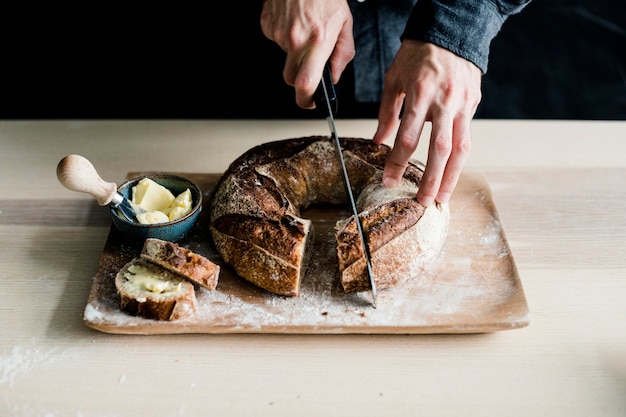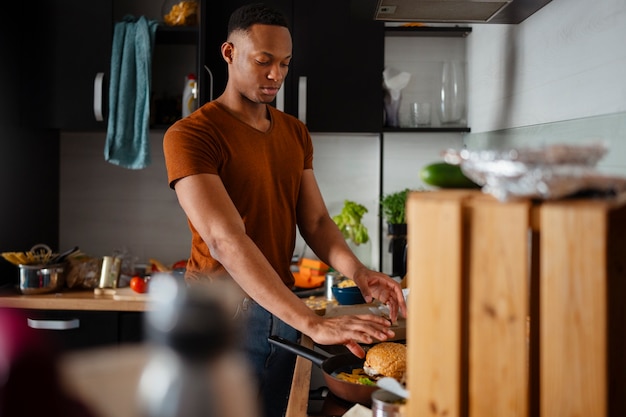There's something undeniably satisfying about cooking a perfect ribeye steak. The sizzle, the aroma, the anticipation of that first juicy bite – it's a culinary experience that elevates a simple meal into something truly special. But let's be honest, facing a hunk of raw meat can feel a bit daunting, especially for someone who's not a seasoned chef. Fear not! I'm here to guide you through the process, sharing my tips and tricks for nailing a perfect ribeye steak on the stovetop, a feat that's easier than you might think. Get ready to embrace the journey, from selecting the right cut to mastering the art of the sear, and together, we'll create a delicious masterpiece.
Part 1: Setting the Stage for Success

choosing the right ribeye: Your Culinary Star
The first step in any culinary adventure is choosing the right ingredients, and for a perfect ribeye, that means finding the star of the show. I'm a firm believer in quality over quantity. Don't be tempted by a massive, overly lean cut. Instead, seek out a smaller, perfectly marbled ribeye – that's the key to juicy, flavourful results. Look for a ribeye with those beautiful, white streaks of fat marbling throughout the meat. These streaks aren't just for aesthetics; they melt during cooking, adding a rich, buttery depth to the steak. When it comes to thickness, aim for a cut that's about 1.5 inches thick. This ensures even cooking, preventing the centre from becoming raw while the edges become overdone.
Prepping the Ribeye: Unveiling the Flavor
Now that you've chosen your perfect ribeye, it's time to give it a little TLC before it hits the heat. First, give it a gentle pat-down with paper towels to remove any excess moisture. This ensures a crisp, even sear. Next, comes the seasoning – and let me tell you, more is more! Don't be shy with the salt and pepper. Think of it as a love letter to your steak, a generous sprinkle that will bring out its natural flavours. A good dose of salt actually helps tenderize the meat, allowing it to soak up the flavour. Give it a good rub all over and let it rest for about 30 minutes. This allows the salt to penetrate the meat, creating a juicier, more flavourful steak.
Part 2: The Stovetop Showdown – Searing to Perfection

Choosing Your Weapon: The Pan That Will Conquer
To achieve that perfect sear, you need a pan that can handle the heat and distribute it evenly. A trusty cast-iron skillet is my go-to choice – its ability to retain heat is unmatched. However, if you don't have a cast-iron, a heavy-bottomed stainless steel pan will work just fine. Avoid thin pans that will warp or lose heat quickly, as they won't produce the desired searing effect.
Heating the Pan: Unleashing the Flames
Now, here's where things get a little dramatic. You want your pan screaming hot, practically smoking! Turn your burner to high heat and give the pan 5-7 minutes to reach its peak temperature. A little trick to check if it's ready – carefully drop a few drops of water onto the surface. If they sizzle and evaporate instantly, your pan is ready to tackle the steak!
The Searing Ritual: A Dance of Fire and Flavor
It's time for the searing ritual, the moment when the steak truly transforms. Carefully place the seasoned ribeye in the scorching hot pan. Resist the urge to move it right away! Let it rest for 2-3 minutes per side, allowing the intense heat to create that beautiful, crusty sear that locks in the juices and infuses it with flavour. You'll hear the satisfying sizzle as the meat meets the pan, and the kitchen will fill with a delicious aroma – pure culinary magic!
Part 3: Mastering the Art of Cooking to Perfection

Flipping the Steak: A Gentle Touch
After achieving that initial sear on both sides, it's time to give the steak a flip. I always give it a quarter turn in between each flip, ensuring even cooking. At this point, you can reduce the heat to medium, depending on your stove's intensity. Remember, it's all about adapting to the heat and ensuring the steak cooks evenly without burning.
cooking time: The Dance Between Doneness and Desire
Now, this is where it gets personal. The cooking time depends entirely on how you like your steak done. I'm a fan of medium-rare, so I cook it for about 4-5 minutes per side. But don't be afraid to experiment! Here's a handy chart to guide you:
| Doneness | internal temperature (°F) | Cooking Time (minutes per side) |
|---|---|---|
| Rare | 125-130°F | 2-3 |
| Medium-Rare | 130-135°F | 4-5 |
| Medium | 135-140°F | 6-7 |
| Medium-Well | 140-145°F | 8-9 |
| Well-Done | 145-150°F | 10-12 |
Remember, these are just guidelines. Every stove, every pan, every steak is a little different. Don't be afraid to use your best judgement and trust your gut! If you're ever unsure, invest in a meat thermometer. It's a culinary hero that will help you achieve your desired level of doneness with precision.
Part 4: The Resting Ritual: A Pause for Flavor
Before you get your knife out and carve into your masterpiece, it's crucial to give the steak a well-deserved rest. This allows the juices to redistribute throughout the meat, resulting in a more tender, flavourful steak. Cover the steak loosely with aluminium foil to keep it warm while it rests for 5-10 minutes.
Part 5: Adding Flavor to Your Creation: A Symphony of Aromas
Butter Basted Glory: A Luxurious Touch
While the steak is resting, it's time to elevate your pan game. Add a knob of butter to the pan, along with some fragrant fresh herbs like rosemary or thyme. Let the butter melt and infuse with the herbaceous aromas. Once the butter is bubbling, spoon it over the resting steak. This adds a rich, buttery flavour and makes the steak even more irresistible.
The Sauce Symphony: Elevating Your Meal
Those delicious pan juices are begging to be transformed into a sauce. This is where the magic of deglazing comes in. Add a splash of wine or broth to the pan, scraping up all those yummy browned bits stuck to the bottom. These bits are packed with flavour! Simmer the sauce for a few minutes until it reduces and thickens, becoming a delicious sauce to complement the steak. For added richness, you can add a tablespoon of butter or a splash of cream. This sauce is the perfect finishing touch, enhancing the flavour of your steak and making every bite a delicious experience.
Part 6: The Grand Finale: A Feast for the Senses
Carving and Serving: A Culinary Presentation
Now comes the moment of truth – carving the steak. I like to slice the steak against the grain. This makes the meat more tender and easier to chew. Arrange the slices beautifully on a plate, creating a culinary masterpiece. Serve with your favourite sides – creamy mashed potatoes, roasted vegetables, a refreshing salad, or whatever complements your palate. And don't forget that delicious pan sauce! Drizzle it over the steak and enjoy every bite of this culinary triumph.
Part 7: Beyond the Basic Ribeye: Exploring New Horizons
Marinating Your Meat: A Flavorful Adventure
If you're feeling adventurous, try marinating your ribeye before cooking it. A simple marinade of olive oil, garlic, and herbs adds a beautiful complexity to the flavour. Or, for a zesty kick, try a citrus marinade with lemon and orange juice. Marinate the steak for at least an hour in the fridge for the flavours to meld and infuse the meat.
Grilling the Ribeye: A Taste of Summer
While this guide focuses on stovetop cooking, there's a special magic to grilling a ribeye. The process is similar, but you'll need to preheat your grill to high heat. Cook the steak for about 4-5 minutes per side for a medium-rare steak. Use a meat thermometer to check for doneness and ensure a perfectly cooked steak.
Part 8: FAQs: Answers to Your Culinary Queries
1. What's the best way to prevent the steak from sticking to the pan?
The key is to have your pan searing hot! If the pan isn't hot enough, the steak will stick. Use a good quality oil with a high smoke point, like avocado oil or grapeseed oil. And avoid overcrowding the pan – if you have a large steak, cook it in batches.
2. How do I know when the steak is cooked to my liking?
The most reliable method is using a meat thermometer. Each level of doneness has a corresponding internal temperature (see the chart in Part 3). If you're not using a thermometer, the touch method is a good option, but it's less precise. Gently press the steak with your finger. If it feels like a soft, yielding surface, it's rare. If it's firm but still springy, it's medium-rare. If it feels firm and almost hard, it's well-done.
3. What if the steak is overcooked?
Don't panic! It happens to everyone. If your steak is overcooked, you can try slicing it thinly and using it in a stir-fry or a pasta dish. Or, simply accept that it's a bit dry and move on. There's always next time!
4. What are some good side dishes to serve with ribeye steak?
The possibilities are endless! Classic pairings include mashed potatoes, asparagus, roasted brussels sprouts, or a simple salad. Get creative and try something more adventurous, like a mushroom risotto or creamy polenta.
5. What are some tips for making a delicious pan sauce?
Use a good quality wine or broth for deglazing. Scrape up all the browned bits stuck to the bottom of the pan – that's where the flavour is! Simmer the sauce until it reduces and thickens. Add a tablespoon of butter or a splash of cream for extra richness. You can also add some fresh herbs or a squeeze of lemon for extra flavour.
There you have it, a complete guide to conquering the perfect ribeye steak on the stovetop. Remember, it's all about practice, patience, and a little bit of culinary confidence. Now go forth, my friend, and impress your friends and family with a steak that's worthy of a standing ovation!
Everyone is watching

How to Cook Frozen Lobster Tails Perfectly: A Step-by-Step Guide
RecipesLobster. Just the word conjures up images of lavish meals, special occasions, and a taste of luxury. But let's...

Pork Fillet Cooking Time: How Long to Cook It Perfectly
RecipesPork fillet, or tenderloin as it's sometimes called, is a real favourite in our house. It's so versatile, and...

Pigs in a Blanket Cooking Time: How Long to Bake for Perfect Results
RecipesAh, pigs in a blanket. Just the name conjures up images of those delightful little parcels of crispy pastry en...

The Ultimate Guide to Cooking Delicious Frankfurters
RecipesLet's face it, we all love a good frankfurter. It's a classic, simple, and always satisfying. But let's be rea...

Wolf Meat Recipes: A Guide to Cooking Wild Game
RecipesLet's be honest, you don't see wolf meat at your local butcher shop every day. It's a bit of a wild card, but ...
